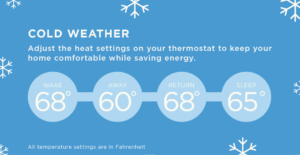Keep Warm and Safe with Indoor Fire Prevention Tips
With the chilly temperatures of winter arriving soon, it’s likely that you will be spending more time indoors. When you aren’t playing in the snow, that is! Each winter we hear stories of homes going up in smoke due to poor electrical maintenance. The presence of flammable material can add literal fuel to the fire. Looking at you, Christmas trees! Property managers can work with tenants in taking the steps needed to prevent indoor fires. Taking a few moments to review the common sources of fire and your emergency plan can save you headaches (and insurance claims) down the line.
Grease Fire Prevention
Cooking delicious food is a common hobby. However, depending on what is being made, there can be a significant risk for a grease fire. Fires in the home can spread rather quickly, which makes prevention an essential part of making your house a home. Grease fires can be prevented by never leaving your pan unattended. Keep some baking soda handy just in case a fire does break out. Keep your cooking area clean and free from flammable materials to further reduce your fire risk.

Electrical and Extension Cord Safety
Sometimes it seems like there is never an open electrical outlet where you need it. This is why extension cords are commonly found in just about everyone’s home. Extension cords allow us to bring the power of electricity where we desire. They help us to illuminate holiday lights and charge our various electronic devices. However, there are some safety issues that may arise that need to be addressed. Never run extension cords under rugs or through windows that will be closed. Doing so can damage the insulation, which could result in an electrical fire.
Clothes Dryer Fire Prevention
There is little that comes close to the comfort that comes from clothes fresh out of the dryer. The appliance that makes dry, warm clothes possible also can be a source of a dangerous fire breaking out. One easy way to prevent a dryer fire is by making sure that you clean out the lint trap either before or after every load. It is also smart to clean out the exhaust dryer duct on an annual basis, as small amounts of lint can build up, even if you clean your lint traps on a regular basis. If you have a gas clothes dryer, you will want to inspect the fittings and connections each year to identify any gas leaks, which can be quite dangerous if left unnoticed.
Smoke and CO Alarms
Even if you take steps to reduce your risk of fire, the inevitable may still happen. In such instances, you will want to make sure that your smoke and carbon dioxide detectors work as designed. A good rule of thumb is to change out the batteries in your smoke and carbon dioxide detectors with the time changes of Daylight Savings. You also want to ensure that you can hear the alarms in each room of your house. Test the smoke detector and any other fire alarms that may be in your home on a monthly basis.

Conclusion
Your home has a variety of potential sources for fire risk. Taking the time to walk through your home to identify any potential issues can reduce your risk though. Whether you’re a tenant or property owner, property maintenance, such as fire prevention actions, is essential to maintaining a comfortable and safe environment. If you’re looking for someone to help you in managing your property in a safe manner, contact the folks over at The Property Manager to see how they can help!
References
10 Tips for Maintaining Electrical Safety at your Rental Homes
How Can I Prevent a House Fire?
How to Prevent and Safely Put Out a Grease Fire in Your Kitchen



